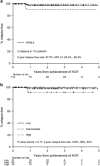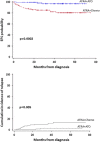Acute promyelocytic leukemia: where did we start, where are we now, and the future
- PMID: 25885425
- PMCID: PMC4450325
- DOI: 10.1038/bcj.2015.25
Acute promyelocytic leukemia: where did we start, where are we now, and the future
Abstract
Historically, acute promyelocytic leukemia (APL) was considered to be one of the most fatal forms of acute leukemia with poor outcomes before the introduction of the vitamin A derivative all-trans retinoic acid (ATRA). With considerable advances in therapy, including the introduction of ATRA initially as a single agent and then in combination with anthracyclines, and more recently by development of arsenic trioxide (ATO)-containing regimens, APL is now characterized by complete remission rates of 90% and cure rates of ∼80%, even higher among low-risk patients. Furthermore, with ATRA-ATO combinations, chemotherapy may safely be omitted in low-risk patients. The disease is now considered to be the most curable subtype of acute myeloid leukemia (AML) in adults. Nevertheless, APL remains associated with a significant incidence of early death related to the characteristic bleeding diathesis. Early death, rather than resistant disease so common in all other subtypes of AML, has emerged as the major cause of treatment failure.
Figures



References
-
- Hillestad LK. Acute promyelocytic leukemia. Acta Med Scand. 1957;159:189–194. - PubMed
-
- Pisciotta AV, Schulz EJ. Fibrinolytic purpura in acute leukemia. Am J Med. 1955;19:824–828. - PubMed
-
- Cooperberg AA, Neiman GM. Fibrinogenopenia and fibrinolysis in acute myelogenous leukemia. Ann Intern Med. 1955;42:706–711. - PubMed
-
- Fisher S, Ramot B, Kreisler B. Fibrinolysis in Acute Leukemia. Israel Med J. 1960;XIX:195–198. - PubMed
-
- Ghitis J. Acute promyelocytic leukemia. Blood. 1963;21:237–240. - PubMed
Publication types
MeSH terms
Substances
Grants and funding
LinkOut - more resources
Full Text Sources
Other Literature Sources

